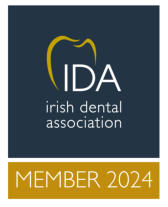Castle Street Dental Practice
(© Castle Street Dental Practice 2025
Castle Street Dental Practice
12 Castle Street
Macroom
Co. Cork
P12 N296
Call us on 026 41487
Email: castlestdp@gmailcom
Opening Hours
Monday 9am to 6pm
Tuesday 9am to 6pm
Wednesday 9am to 6pm
Thursday 9am to 6pm
Friday 9am to 6pm



Crowns
Bridges
Veneers
What are Crowns and Bridges?
Both crowns and most bridges are fixed prosthetic devices. Unlike removable devices such as dentures,
which you can take out and clean daily, crowns and bridges are cemented onto existing teeth or
implants, and can only be removed by your dentist.
How do Crowns work?
A crown is used to entirely cover or 'cap' a damaged tooth. Besides strengthening a damaged tooth, a
crown can be used to improve its appearance, shape or alignment. A crown can also be placed onto an
implant to provide a tooth-like shape and structure for function. Porcelain or ceramic crowns can be
matched to the colour of your natural teeth. Other materials include gold and metal alloys, acrylic and
ceramic. These alloys are generally stronger than porcelain and may be recommended for back teeth.
Porcelain bonded to a metal shell is often used because it is both strong and attractive.
A crown could be recommended to:
-Replace a large filling when there is not enough tooth remaining
-Protect a weak tooth from fracturing
-Restore a fractured tooth
-Attach a bridge
-Cover a dental implant
-Cover a discoloured or poorly shaped tooth
-Cover a tooth that has has root canal treatment
How do Bridges work?
A bridge may be recommended if you are missing one or more teeth. Gaps left by missing teeth
eventually cause the remaining teeth to rotate or shift into the empty spaces, resulting in a bad bite.
The imbalance caused by missing teeth can also lead to gum disease and temporomadibular joint (TMJ)
disorders. Bridges span the space where the teeth are missing. Bridges are cemented to the natural
teeth or implants surrounding the empty space. These teeth, called abutments, serve as anchors for
the bridge.
How long do Crowns and Bridges last?
While crowns and bridges can last a lifetime, they do sometimes become loose or fall out. THe most
important step you can take to ensure the longevity of your crown or bridge is to practice good oral
hygiene. A bridge can lose its support if the teeth or bone holding it in place are damaged by dental
disease. By brushing twice a day and also flossing daily can help keep your gums healthy. Also ensure
that you visit your dentist and dental hygienist for regular check-ups and cleaning.
To prevent damage to your crowns or bridges, avoid chewing hard foods, ice or other hard objects.
Veneers
Dental veneers are versatile and relatively conservative ways to change the colour, form, and shape of
your teeth in order to improve your smile. Sometimes veneers are done in conjunction with teeth
whitening and/or orthodontics in order to achieve the best results possible.
Veneers are either made of composite filling material and can be done in one visit or can be made of
ceramic/porcelain which provides the best aesthetic results but will require at least 2 appointments.
Our dentists will be happy to discuss which option would be best suited to create the smile you want.

Castle Street Dental

© Castle Street Dental Practice 2025


Crowns
Bridges
Veneers
What are Crowns and Bridges?
Both crowns and most bridges are
fixed prosthetic devices. Unlike
removable devices such as dentures,
which you can take out and clean
daily, crowns and bridges are
cemented onto existing teeth or
implants, and can only be removed
by your dentist.
How do Crowns work?
A crown is used to entirely cover or
'cap' a damaged tooth. Besides
strengthening a damaged tooth, a
crown can be used to improve its
appearance, shape or alignment. A
crown can also be placed onto an
implant to provide a tooth-like shape
and structure for function. Porcelain
or ceramic crowns can be matched to
the colour of your natural teeth.
Other materials include gold and
metal alloys, acrylic and ceramic.
These alloys are generally stronger
than porcelain and may be
recommended for back teeth.
Porcelain bonded to a metal shell is
often used because it is both strong
and attractive.
A crown could be recommended to:
-Replace a large filling when there is
not enough tooth remaining
-Protect a weak tooth from fracturing
-Restore a fractured tooth
-Attach a bridge
-Cover a dental implant
-Cover a discoloured or poorly
shaped tooth
-Cover a tooth that has has root canal
treatment
How do Bridges work?
A bridge may be recommended if you
are missing one or more teeth. Gaps
left by missing teeth eventually cause
the remaining teeth to rotate or shift
into the empty spaces, resulting in a
bad bite. The imbalance caused by
missing teeth can also lead to gum
disease and temporomadibular joint
(TMJ) disorders. Bridges span the
space where the teeth are missing.
Bridges are cemented to the natural
teeth or implants surrounding the
empty space. These teeth, called
abutments, serve as anchors for the
bridge.
How long do Crowns and Bridges
last?
While crowns and bridges can last a
lifetime, they do sometimes become
loose or fall out. THe most important
step you can take to ensure the
longevity of your crown or bridge is to
practice good oral hygiene. A bridge
can lose its support if the teeth or
bone holding it in place are damaged
by dental disease. By brushing twice
a day and also flossing daily can help
keep your gums healthy. Also ensure
that you visit your dentist and dental
hygienist for regular check-ups and
cleaning.
To prevent damage to your crowns or
bridges, avoid chewing hard foods,
ice or other hard objects.
Veneers
Dental veneers are versatile and
relatively conservative ways to
change the colour, form, and shape
of your teeth in order to improve
your smile. Sometimes veneers are
done in conjunction with teeth
whitening and/or orthodontics in
order to achieve the best results
possible.
Veneers are either made of
composite filling material and can be
done in one visit or can be made of
ceramic/porcelain which provides the
best aesthetic results but will require
at least 2 appointments. Our dentists
will be happy to discuss which option
would be best suited to create the
smile you want.















